Here is my list, in no particular order:
The Steel Bridge lower deck/floating Esplanade. Created thanks to the Bike Bill and Street Trust lawsuit, this is the most spectacular of the crucial bridge and waterfront connections that made Portland’s eye-popping biking boom of the 2000s happen. The floating section of the Esplanade is one of the city’s most wonderful public spaces.
Clinton Street’s traffic diverters. The old one at Chavez improbably turned a busy commercial collector into a bikey commercial street and also created the single most bike-friendly crossing of Chavez; the new ones, created by direct activism in the face of city staff opposition, turned the bikey commercial street into a truly comfortable commercial bikeway.
Advertisement
The dedicated bike signal phases at Broadway & Williams. This happened before my time so I don’t really know the story but the care with which this was done, I think the illegality with which it was done, and the indisputable rightness of it, all make this little detail extraordinary IMO.
The Go By Bike valet at SW Moody and Whitaker. It’s a simple idea that most cities would have drowned in bureaucracy. It’s been growing each year by double digit percentages. It makes acres of parking lots unnecessary, saving OHSU millions. It’s the most visually spectacular testament to the city’s bikeability. It boosts bike use despite not being in any transportation demand management handbook, because nobody has ever bothered to calculate the psychological effect of just seeing other people use bikes and making it stupidly simple to join them.
The 11 mph green wave on downtown streets It’ll never recruit the uninitiated for the same reason it’s so effective: it’s invisible. The traffic signal timing on downtown’s one-way streets makes the entire downtown comfortable for riders who are confident enough to discover it, and without a single moan from anyone in a car. That’s not to mention the fact that it makes most downtown traffic nonlethal, saving countless lives and limbs.
The first 100 bike corrals. This is the only item on this list that might be unique by international standards. The quality of bike parking in central Portland’s streetcar-era commercial districts is, as far as I can tell, unmatched. The program was designed by city bureaucrats who used existing materials creatively for the audacious goal of making bike parking plentiful and convenient. Their successful application strategy of just waiting for businesses to ask for them is almost as audacious.
…And the number of bikes parked around the bottom of the Portland Building. Not the terrible wheel-grabbing parking machines, but the number of them that are used by city employees from every bureau … and, along with it, the number of car parking spaces on site at the Portland Building. (Almost zero.) More than any other single factor, this might be the driving force behind Portland’s relative bike-friendliness.
If I were still writing regularly for the site I would pitch Jonathan on a series where we looked at each of these and told the story of how it happened. Anybody (including Jonathan) want to do that?
And what items are on your list?
— Michael Andersen, @andersem on Twitter.
This post was submitted as a Subscriber Post, one of the benefits of being a paid supporter of BikePortland. Learn more here.




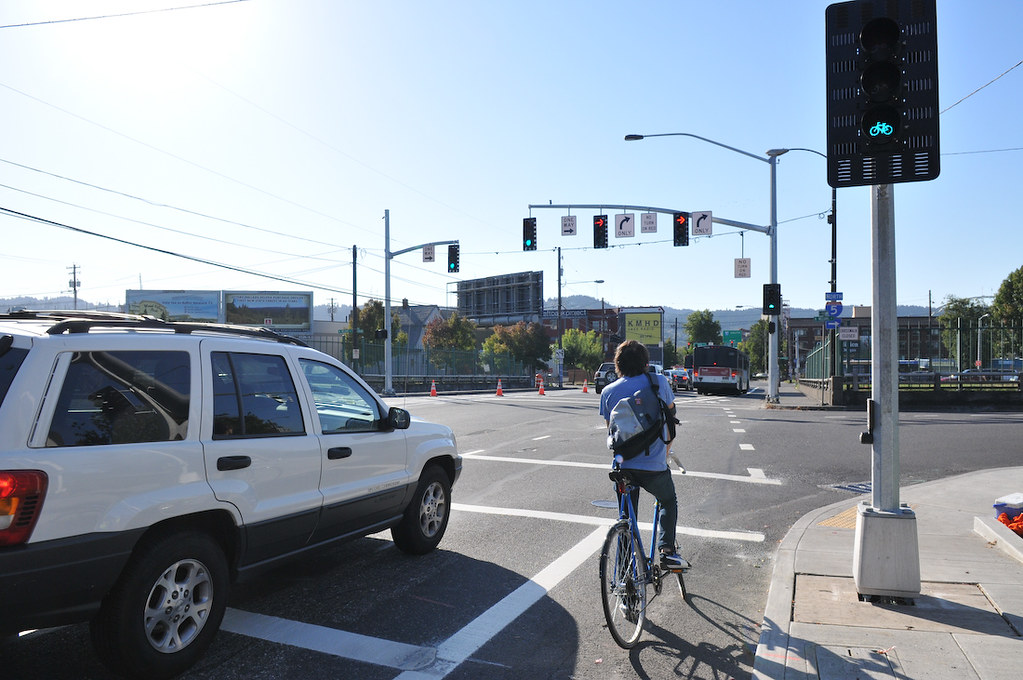

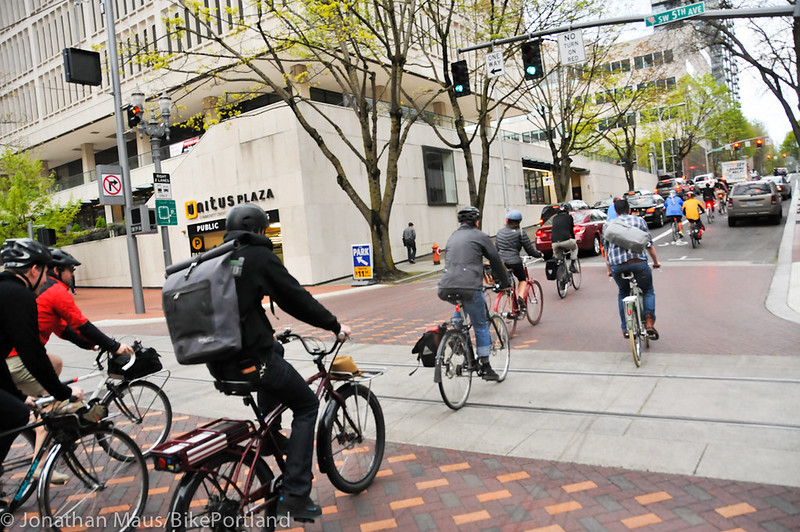
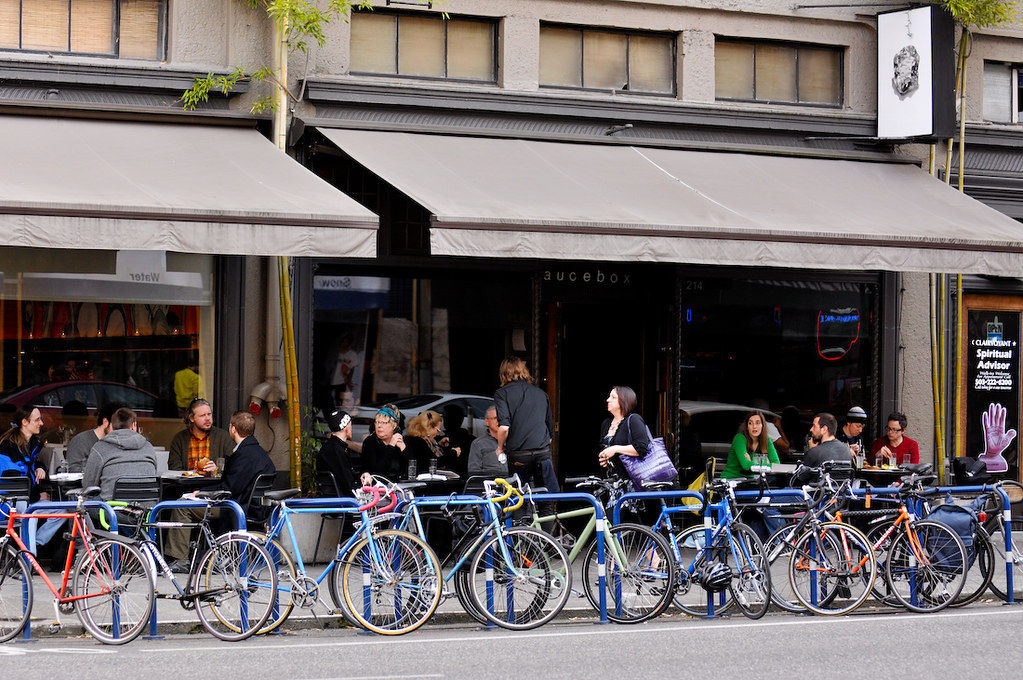
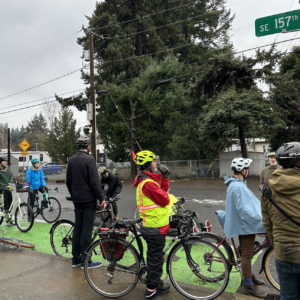
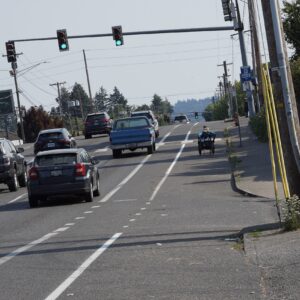
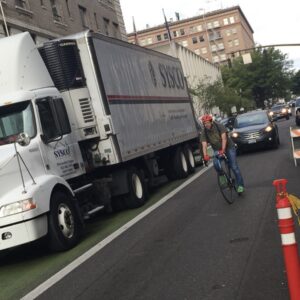
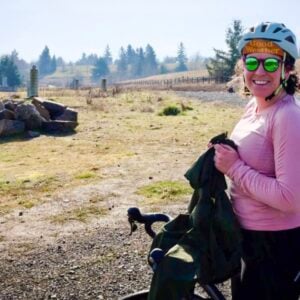
Thanks for reading.
BikePortland has served this community with independent community journalism since 2005. We rely on subscriptions from readers like you to survive. Your financial support is vital in keeping this valuable resource alive and well.
Please subscribe today to strengthen and expand our work.
The bike valet by OHSU was one of the main factors encouraging me to get back to riding a bike. Not every doctor’s office / dentist office has great parking / watchful valet like that.
The Broadway/Williams signal was constructed as part of the Streetcar Loop project and as I recall the big argument at the time was whether it could get built earlier in the project 🙂
The old design was terrifying, threading between two-right turning lanes of freeway on-ramp traffic!
Thanks for publishing, Jonathan! For the record, after I wrote this Cameron Whitten and Tony Jordan chimed in on Facebook to nominate the Zoobomb Pyle statue. I think that’s a great way to capture the effect of bike fun in an infrastructure list. If I were going to swap that in, I guess I’d remove the Steel Bridge/Esplanade.
A bunch of people thought I should include Tilikum, too, but the truth is that a really nice bike-ped bridge is not nationally unique. What’s unique about Tilikum is that it allows buses but not cars. It’s one of the seven public transit infrastructure wonders of Portland for sure, but that’s not the task at hand.
I think one of the best bicycle infrastructure features of Portland is the traffic signal bicycle detection indicator. That’s the little blue light that has been spreading to traffic signals throughout the city. 21st and Division is one such location; several intersections along the Max Orange Line, such as crossings at 12th Avenue and at Milwaukie, let bicyclist know for certain that their presence has been detected by the signals. Great work by Peter Koonce and his crew!
I love these too. Carl Alviani did a great post about them from a few years ago:
https://medium.com/re-form/the-traffic-signal-knows-youre-there-d9e6d690dffe
oh that’s what those blue lights are for? I didn’t know that. That’s handy.
The Bike Valet is outstanding and we need more such facilities. The Esplanade seems like it would be awesome but it doesn’t quite work for cycling the way one would hope (really, it functions a lot like the waterfront), and most of the other things are good examples of what we should continue to build.
I actively dislike the 11mph green wave because I think that the well intentioned measure significantly increases right hook occurrences while slowing down cyclists and traffic alike too much.
Real progress is more about ordinary but helpful improvements rather than showcase projects that some would describe as wonders. For example, Interstate is way more rideable than it was some years back. Designating greenways so that cyclists and motorists alike know where to expect slower and faster streets is good. Dedicated signals where a large number of cyclists needs to do the same thing such as turn left off the Broadway Bridge onto Broadway or left off of Steel Bridge onto Interstate. Baby steps.
I don’t get it – how does the downtown green wave boost right hooks?
I see a lot of people get hooked. It does this in two ways:
1) Cyclists often wind up riding next to cars that are going the same speed. This makes it difficult to anticipate cars turning either because the motorist didn’t think to look or because the cyclist is in a blind spot.
2) It encourages faster cyclists to pass on the right of vehicles that might turn right. Because of the number of cyclists and peds on some streets, it makes timing turns for drivers more difficult and increases conflicts.
The slow speeds tend to cause groups of cyclists to bunch up which amplifies problems when either of the above happen. The slow speeds and slow response times from motorists and cyclists alike after light changes lead to more drivers/cyclists getting trapped by lights which encourages more erratic behavior.
There is a lot going on with peds, cyclists, cars, etc coming from different directions so speeds need to be low. But it’s too low and a few more mph would improve flow and make things safer.
Huh, thanks. I respectfully but definitely disagree.
Here’s what I think increases right hooks: *cars that travel faster than bikes*. And here’s what I think the effect of “slow speeds and slow response times” is: more time for everybody to react and prevent collisions.
“I see a lot of people get hooked.”
in my approx two decades of daily cycling in pdx i’ve only witnessed two hook-type collisions (and both were due to aggressive overtaking by people driving).
might i suggest that you could take some of your own advice when it comes to exaggeration of the safety risks of cycling.
I frequently see a lot of people get hooked, particularly going up Broadway. Gaggles of cyclists move about the same speed as the cars or they overtake vehicles on the right without verifying that it’s safe to do so. There are a few other places that seem prone to hook activity. I sometimes see people get into situations on Interstate.
In any case, commenters on this blog frequently complain about getting hooked.
If a person is right hooked on SW Broadway, that’s a bike-lane thing, not a matching-speeds thing. The best place for a bike (or any vehicle going straight through an intersection) downtown on a three-lane street is in the middle lane. It’s technically illegal, but so what? It’s also unenforced. The SW Broadway bike lane, below Salmon Street, is of no use. Any cyclist is better off taking the lane in that area to avoid multiple right-hook hazards, not to mention that the bike lane is mostly within the door zone. I knew someone who got killed in the SW Broadway bike lane.
I agree with this basic assessment and constantly take the lane for this exact reason — no one has ever hassled me for this. Otherwise, you have to slow down a bit and be ready just in case the vehicle turns or throw caution to the wind.
It’s a bad bet to assume that every driver will check behind them to see if they’re being overtaken on the right by what is normally the slowest thing on the road before turning or that if they do, they’ll see the cyclist.
Really? When I ride from my office at the very SW end of SW 4th down to Burnside during evening rush hour, I nearly always take the middle lane because it’s so much faster and avoids all the hooks. I had no idea what I was doing was considered illegal. Since it’s very east to keep pace northbound/downhill I think I’m going to just keep doing it 🙂
To be honest, I prefer cars traveling faster than me unless I’m in the lane — their intent is much easier to read if there’s a speed differential, you can see their approach, and there’s plenty of time to react and space to work with than if they’re next to you where they can suddenly turn and you only get a fraction of a second in the exact place you’re in.
I don’t ride next to cars — if they insist on driving the same speed as me, I either pull in front or behind them. Likewise, I don’t pass on the right except when it’s clearly safe to do so. Seems to keep me from getting hooked in places where I see it happen to others on a regular basis.
Likewise, the slow speeds and response times get everyone bunched up. This makes it impossible for the people in front to react quickly to anything without causing problems for others. Despite the low speeds, it reduces rather than increases reaction time and it reduces evasive action options as well. I’ve seen groups of people get into trouble in situation where no one should have had a problem.
If we had a dedicated lane, you would have enough space to go 22 and still hit the greens, right? A parking-protected lane works well with turn restrictions (of which Broadway needs far more.) 4th is nice, but usually has too many cars in the way.
“If we had a dedicated lane, you would have enough space to go 22 and still hit the greens, right?”
Uh, no. Not even close. If you drive or ride at 11 mph, you go one block (200 feet) in about 13 seconds. If you go 22 mph, it’s about 7 seconds. You simply get there soon enough to wait for six seconds before the light turns green.
Correct — you cannot go faster than light timing except for short distances. Otherwise, you simply catch the next light.
That it’s even an issue to overrun lights going uphill on a steel bike with panniers from the bottom of Broadway past PSU and 405 is ridiculous. Downhill is so slow it’s downright painful. 4th is consistently too gummed up to be usable IMO — Naito is a better option unless your destination is in the core itself.
I actually agree that I feel more nervous when a car is pacing alongside of me than if they are going faster or slower. It is much harder to tell if they are aware I’m beside them and I don’t have the ability to read what they are doing (slowing for a turn, using a signal, etc.). I feel less able to react to the driver, so I can see Kyle’s POV on this one. That said, I appreciate it when I’m heading south on downtown streets and can keep up with the greens.
The diverters on Clinton have made SUCH a difference. Diverters on every bike boulevard, every few blocks now!
My favorite anecdote about the history of Clinton is also my favorite anecdote about the future of NE 7th Avenue, and it came from Carl Larson: Before the Chavez diverter, Clinton had approximately as much auto traffic as NE 7th does today.
Change is possible!
its been over a year since a new traffic-calming device/diverter has been installed. imo, negative pushback from other bike advocates is a big reason movement towards more traffic calming/diversion on greenways has stalled. bike advocates in pdx eat their own.
V,
You must mean a permanent diverter.
15th and Ankeny diagonal test was installed in May.
Also, the pace of installs is a function of programming projects, and the fixing our streets funding has not yet kicked in for bike projects.
Ladd/Harrison/Lincoln is likely to have two.
The PBOT “Portland By Bicycle” map, in full-size and mini versions. When I started riding my bike in Portland, that map was my bible, I carried it everywhere, it helped me learn my way around the city and find all of these infrastructure wonders. I think it is really cool how it is so easy to pick up a copy of this map free or order free copies online. It’s like our own Key To The City.
Although….
https://bikeportland.org/2015/12/17/why-would-anyone-ride-on-that-scary-stretch-of-lombard-170484
Thank you for this post. Portland really has done a great job with accommodations for biking, and it’s a nice reminder to see them listed here. I agree that the bike corrals are one of the most significant. However, I still think that we’ve been resting on our laurels for too long.
Look at Minneapolis or Washington, DC. They are far ahead of us in terms of bike paths and overall quality and connectivity of bike routes. With the exception of Springwater and Marine Drive, our bike paths are really disconnected and slow (I-205 path, for example). To be sure, Portland is limited by its existing layout and geography, but we can do better. Instead of spending $1 billion on adding a lane to a freeway, think of what even 10% of that could do for bike infrastructure. For example, a bike path along I-84 that connected the Eastbank Esplanade to Gateway Green would be a tremendous improvement. It would be costly given the extremely limited space and railroad easements, but it could be done.
Much more feasible in the short term would be to fast-track the north-south bike routes on the East side. Make 2-3 bike express routes on surface streets, with limited stops for bikes and frequent car barriers a la Clinton St, and build new bike/ped bridges over I-84. Biking between NE and SE is a real hassle right now. This impacts both commuting/errand trips and recreational biking. I recognize how much progress has been made, but let’s keep pressure on to take it to the next level!
Fully agree, with the possible exception of DC being that much further along than we are on networking their top-notch facilities. DC has been resting on its laurels, too, acquired a few years after ours.
“The 11 mph green wave on downtown streets”
I used to do this driving downtown on Market between Hwy 26 west and Hwy 26 Powell… it really annoys other drivers… I would just keep it in first gear and idle down to Naito without needing to use the gas or brake pedals…
If your method is more or less paced with the lights, it’s the fastest and safest way so they have no case. If it’s much slower than the lights and causing people to get caught, you’re needlessly blocking and causing traffic problems.
I can’t remember the timing on that particular street, but they all seem painfully slow on a bike so I can easily believe that just letting it ride in first is legit.
About the list — the most noteworthy things should be things that are
– unique or unusual in the US
– major features in the Portland bicycling game
– took significant $ or political will to implement
Add to the list —
* Tilikum Bridge
* Greenway Policy from August 2015 calling for actual engineering and management of greenways that are guarantee they are conducive to heavy bicycle traffic.
https://www.portlandoregon.gov/transportation/article/542747
* Portland Bicycle Master Plan for 2030 that calls for 25% bicycle mode share
https://www.portlandoregon.gov/transportation/44597
* The Portland 1996 Platinum Plan, that was the basis for making Portland the fabulous bike city that it became by 2010.
http://www.portlandonline.com/shared/cfm/image.cfm?id=40414
And, a comment on the list, Portland doesn’t have a lot of truly remarkable pieces of infrastructure. What it does have is an awful lot of people willing to use pretty average infrastructure…
Take from the list —
* Clinton St. Diverters — even though it did take a herculean amount of political will, it *shouldn’t* have. So it’s something of a black eye in my mind, that it took so much citizen effort to get something so essential for basic bikeway functionality. And it was an off-the-shelf fix…
* Williams/Vancouver bike signal — it’s still pretty lame. A modest band-aid to a significant barrier that makes it passable, but not good.
And, a possible historical list, of things Portland was the leader in in 1996 – 2008, before ambition for greatness evaporated
* Blue bike lanes
https://nacto.org/…/2011/01/Portlands-Blue-Bike-Lanes.pdf
* Expanded sidewalk width on the Hawthorn and Broadway bridges
http://www.maine.gov/…/022510PortlandHawthorneBridgeCas…
(with before/after photos)
* Early Bike Boulevards — Tillamook, Ankeny, Salmon, Clinton
https://www.portlandoregon.gov/transportation/article/476096 (undated article)
* Critical Mass (not infrastructure, but likely crucial for political will to build infrastructure). Over 1000 people taking to the streets once a month for years, in the face of arrests and police brutality.
https://www.facebook.com/aftermass/
Thanks for the post, Michael!
Ted Buehler
“Portland Bicycle Master Plan for 2030 that calls for 25% bicycle mode share”
…which in the current update to the TSP is being revised down to 15% bicycle mode share by 2035. PBOT staff don’t think it’s a realistic goal given current / projected land uses. 🙁
!?
I don’t blame you for being surprised. I too wouldn’t expect them to come up with something realistic.
Unusual in the US: PBOT implementing signal detection loops that recognize bicycles (and mopeds/motorcycles) citywide. Not totally consistent, but far better than most US cities. Multnomah County also put in unique detectors in East Portland just before it was annexed by Portland, round rubber things in the street, where all the loops converge, such as at Glisan & 102nd – you trigger them with your front wheel, a bit like a pedestrian button.
Here in Greensboro, as elsewhere, at most signals we have to wait for a car to come to trip the signal – it makes you feel less than second-class.
It’s like that at pretty much all of the intersections I use in Washington County. Very spotty.
Good article.
…and Perhaps in 5 years, there will be a follow-up article…from the opposite side of the coin:
The 7 barriers to bike-as-transport adoption in Portland (to surpass 15% daily citywide bike commuting in order to reach the planned 25% mode split):
< bike sales tax (once implemented)
< Williams Bikeway (esp. New Seasons section)
< Failure of Police / Courts / DMV / Legislature "System" to systematically remove chronic dangerous drivers
< No change (east west road diets) to West Burnside, Hawthorne for bike lanes with pedestrian enhancements vs long standing status quo
< City streets flooded with cheap EVs and un[der]regulated AI-TNC vehicles
< City leadership quietly cuts budget for Vision Zero, due to incomplete implementation
< The Streets Trust continues to choose not to use the court system to push for CoP budget / traffic safety changes…
< …..insert other nominations here…
and…
< CoP quietly adoptes new bike plan or TSP that pushes 25% Bike mode split to 2050…
The only way this would happen quietly is if there’s no BikePortland in five years!
Have a look at page 164 of the current update to the TSP….
https://www.portlandoregon.gov/transportation/article/640080
And I think Jonathan said on Twitter that he’s working on a post about this, no?
Yes – wasn’t sure if you had seen that / was aware of this. Was replying to the reference to “five years”… i.e. it’s not a hypothetical future issue, but something happening now.
Point taken. (Especially if you are still crunching the data and writing guest articles!)
Widening the sidewalks on the Hawthorne Bridge was a great project.
Yes, that project made the Hawthorne the great bike bridge that it is today. (Although believed by many to be the busiest bridge for bikes in the country, I believe that title goes to the Washington Avenue Bridge here in Minneapolis – sorry! Can’t help myself) But the Hawthorne is still awesome.
While we’re on the topic, don’t forget that was just one of several major bridge projects in the late 90s-early 2000s. We had basically one bridge closed for restoration every summer … for several years in a row. Also:
– Widening the sidewalk on the Ross Island Bridge back in the late 90s. Yes, as unpleasant as it is now, it was barely physically passable before, with crumbling guardrails.
– Widening the sidewalk on the Morrison Bridge a few years ago.
– I think the Broadway or Burnside may have gotten bike/ped improvements/widening in their refurb projects too, but I never rode them often enough for me to say for sure.
Broadway did a few years ago, it became slightly wider with fewer obstructions. I think they are working on Burnside right now, but neither will ever be as good as Hawthorne.
According to Wikipedia:
Hawthorne Bridge has over 8,000 bicycles/day
Washington Ave Bridge 6,850 bicycles/day
Brooklyn Bridge has 3,100 bicycles/day
No. Not even close. The Hawthorne Bridge’srecord was a bit over 8,000 bicycles per day.
Its consistent average has been just under 4,000 bicycles per day since the Tillikum opened. Even prior to that, it peaked at around 5,000 bicycles per day. Sorry.
Source:
http://portland-hawthorne-bridge.visio-tools.com
Regarding the Bike Valet — ” It’s the most visually spectacular testament to the city’s bikeability”
What it really is is a testament to the absolutely hopeless parking and driving sitation at OHSU. That doesn’t change the fact that making bike storage convenient and safe is a major incentive and that this specific measure needs to be more commonplace.
I’m not sure how many of you are aware of this, but at least the last time I heard, OHSU has an 8 year waiting list for a parking permit and those cost a fortune. And getting off the hill is miserably slow. Why anyone would want to drive that if they didn’t absolutely have to is beyond me. BTW, for those of you who celebrate traffic mayhem, the tram will close for 5 weeks next year for scheduled maintenance. Sadly, I’m certain it will also hose everyone except for those who pedal or walk the hill as the buses and shuttles will also get caught in the mess.
Correction: the downtown Green Wave is not a fixed 11 mph! Having taken Peter Koonce’s signal timing class at PSU a few years ago, I can tell you that it actually varies depending on the “program” in use at the time. IIRC you will see a progression speed somewhere around 12-13 mph at busy rush hour times, and as high as 18 mph late at night.
This is true (I may well have learned it from you in a previous comment) but I didn’t want to get into that level of detail for a subscriber post.
Um, let’s not give the Street Trust credit for something that happened before they existed, yes? I believe the organization was the Bicycle Transportation Alliance when the lawsuit went down that gave ride to the Steel Bridge bike-ped path.
We use “Oregon Walks” for things done by the Willamette Pedestrian Coalition before it rebranded. Same style here.